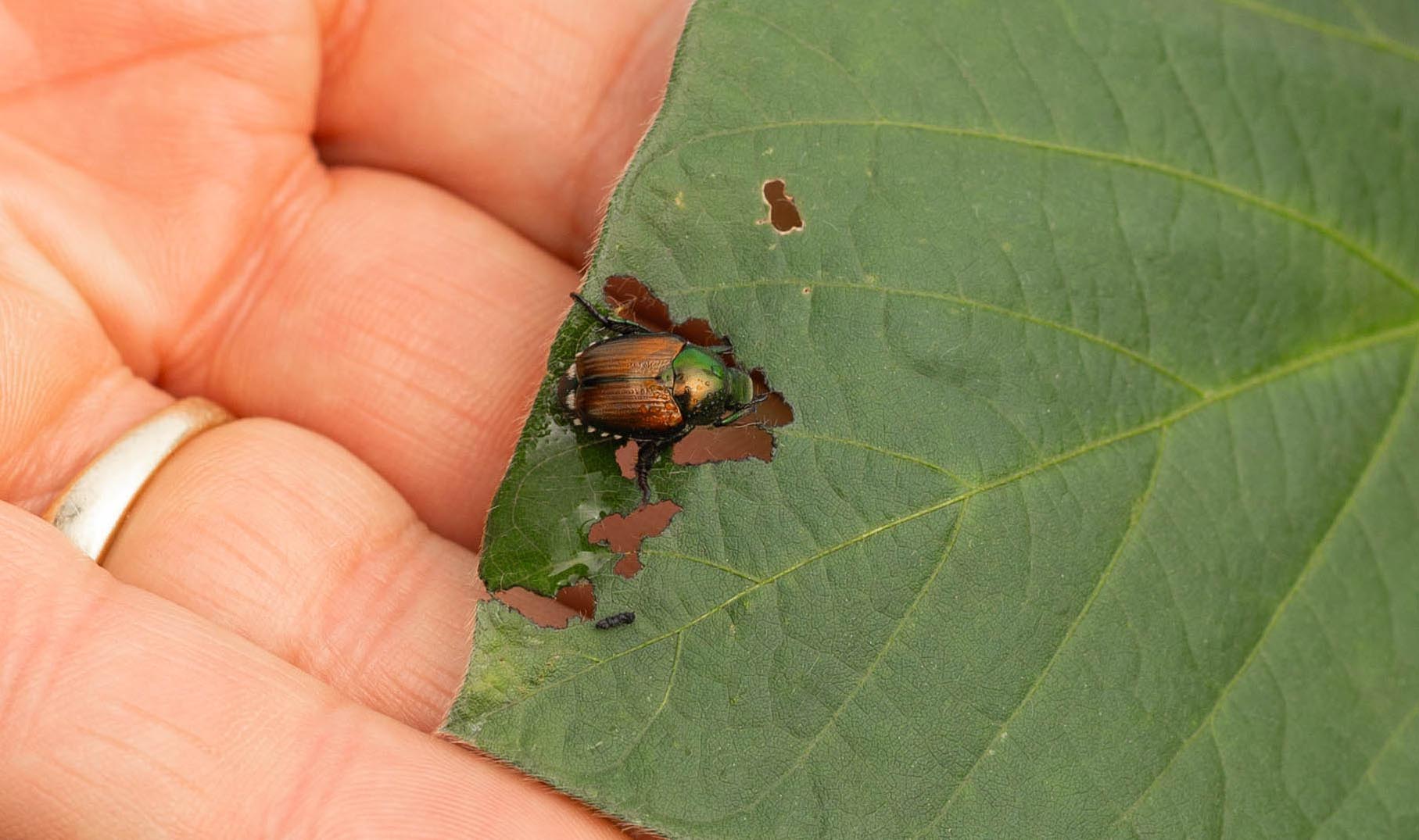
(Photo: Iowa Soybean Association / Joclyn Kuboushek)
Walking Rows: Mid-season pest and disease alert
July 17, 2025
Although rains have been timely, some have been excessive in parts of the state. Iowa Soybean Association (ISA) research agronomists remind farmers to continue to scout for mid-season pests and to be aware of disease that may warrant a fungicide application.
Alex Schaffer - Central/South Central Iowa
Over the past two weeks, the corn and soybean crops have really moved along with the heat and ample moisture. Most of the soybeans are now at the R2 growth stage and much of the corn crop has reached VT/R1. This is a time when both crops are susceptible to stress as corn will abort kernels and soybeans will abort flowers.
When you think about soybean development, they are probably in their most demanding stage, as they are balancing the support of rhizobium nodules, early pod development and vegetative growth all at the same time. The good news is because soybeans have such an extended flowering period, they are more likely to rebound from a short period of stress unlike corn, whose pollination window is relatively short, and a week of hot and dry weather during the wrong week in July can really impact yield.

Talking with farmers recently, I think it will be a big year for fungicide applications in Iowa given the recent rains.
Corn fungicide application time is right on top of us, and soybean application at R3 is right around the corner. The goal of a fungicide application on soybeans is to relieve stress on the plant at pod fill time and ensure the crop leaves are fully capable of converting sunlight into sugars via photosynthesis to fill the pods.
It is also interesting to talk to farmers about decision-making this time of year. The other thing farmers are balancing with a fungicide application is damage to the crop from the application itself. It is important to consider ROI on a fungicide application, not only from a disease or product standpoint, but also think about the crop you are going to run over with the ground rig or the corners of the field you might not be able to hit with an airplane. Drones have been very popular for this reason and give farmers another option during the busy fungicide season.
I've heard reports from Illinois that the crop looks pretty good but is also turning a bit dry. We've been very fortunate with timely rains, although some have been a little excessive. I think if we can catch another couple of rains over the next 6-8 weeks, we will be in really good shape for the 2025 crop year.
Shane Beck – Northeast/Northern Iowa
Wet weather seems to be a trend over the last couple of weeks and may be continuing into next week.
Overall, the crops appear to be in good condition across the north-central and northeastern parts of Iowa. The storms last week caused some corn to be blown over, but it should recover and stand back up here soon. There were also a few streams and rivers out of their banks in the northeastern part of the state. All the water has receded, and I think the crops will survive, although they may slow down developmentally due to mud covering a significant portion of their leaves.

This hot, humid weather is a prime environment for fungal diseases. Soybeans are anywhere from R1-R3. We will soon be in the ideal window for applying fungicides if we choose to do so. I recommend scouting before applying those fungicides to a soybean field. The results from our last two years of fungicide data suggest there is only a 1 bushel per acre (bu/ac) advantage to applying a fungicide to a field without significant disease present. This could be an area where we could potentially save a little money if we do not have disease progression in a field. This environment suggests that we should expect disease to be present this year. However, if the weather turns hot and dry in the next few weeks, we may not see the disease progress at the same rate.
There are reports of tar spot all over the state, and we are under prime conditions for
gray leaf spot next week. Northern corn leaf blight will also be a concern in the coming weeks.
As the corn tassels or is already tasseling, this is a great time to scout your fields for any diseases present. This will help make the management decision on whether to apply a fungicide.
I have heard of a fair number of corn rootworm beetles emerging and being found in fields. Scouting is important because we would like to wait before spraying until we reach the peak emergence to ensure we are effective with our insecticide.
Mikaela Connelly - Southwest/West Central Iowa
Districts 4 and 7 have both received some rain over the last couple of weeks, which was much needed and very timely, given the crops' growth stages.
Typically, it's hot and dry, which isn't what this July has been like or is predicted to be like in the next couple of weeks. I have heard of some wind damage in corn in both districts due to the strong winds during recent storms.
The soybean fields are highlighting low-lying areas where excess water is present, and corn fields are showing some yellowing in the lower canopy due to reduced nitrogen.

Early-planted corn is at R1/R2, and early-planted soybeans are also around R2/R3. Fungicide applications have begun and are expected to continue if the weather cooperates.
I have seen some bacterial blight in soybeans, which can't be treated with fungicides. Farmers should scout for bacterial leaf streak, northern corn leaf blight, gray leaf spot and tar spot as corn continues to mature. Otherwise, disease pressure has been minimal so far. Continue to scout your fields prior to making a fungicide application.
Japanese beetles are becoming more common in soybean fields as well as soybean gall midge. In corn, scout for corn rootworm.
Wet conditions have kept some farmers from baling their second and third cuttings, but overall, crops in my area are looking good.
Craig Woods – Northwest Iowa
Soybeans are developing well and are moving into their R1-R3 growth stages, while canopies are closing or have closed. Corn ranges from the late V stages into R2. Rain and field conditions remain at the top of farmers’ minds as they focus on hitting the key window for fungicide applications, which is late R1 into R2 for corn and around R3 for soybeans.

I have observed minimal insect pressure in the fields I visited, aside from occasionally encountering Japanese beetles. In addition to Japanese beetles, farmers should continue to scout for insect pressure from soybean gall midge and diseases such as gray leaf spot. Waterhemp escapes have been the biggest problem.
Despite the fields that I have scouted having low disease and insect pressure, catching small issues before they get out of hand, causing yield loss, is still best done through scouting. Catching instances of fungal diseases early can allow for adjustments in fungicide applications that may be better rated to handle the current issue you are facing.
For a fungicide efficacy chart, click here.
Lucas De Bruin - Southeast/Eastern Iowa
The crops in districts 6 and 9 are doing very well. I have received reports suggesting that recent winds could negatively affect some crops within District 6.
Soybeans are getting good height and growth. The corn is nearly 90% tasseled in my area, with fungicide applicators staying busy and will for the next few weeks.

Small grains harvest is underway, and that means relay cropping rye harvest is beginning or almost over in some cases. I’ve talked to a few guys with relay cropping that have said this is the best rye they have ever had. I would contribute that to the excellent conditions and moisture we’ve had this growing season. There have been a few challenges with harvestability for some small grains as the soybeans have done an excellent job of growing. Some wheat could not be harvested because of the height of the beans.
Overall, everything looks great. There has been abundant moisture. Corn is close to being set for the year. A couple of late August rains could make for a fantastic soybean crop.
Gathered by Kriss Nelson.
Back